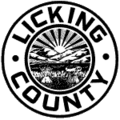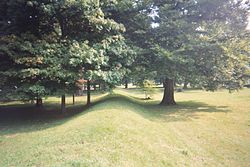Since Licking County's establishment in 1808, businesses and industries have served as a source of employment, generating income and promoting economic growth. Notable industries include manufacturing, retail and wholesale trade, health care and social assistance, accommodation and food services. Manufacturing, agriculture, and services prove to be the major sectors of Licking County's industry. [28]
Manufacturing
Manufacturing is one of the largest industry sectors in Licking County. [29] Major establishments and advancements have been made by manufacturing facilities in the county by renowned companies or corporations, namely Invenergy , Armstrong World Industries , Intel , and Atkore. [30] [31] These investments have provided Licking County residents with a diverse range of employment opportunities and facilitated its economic growth. However, in the past many other successful manufacturing companies have come to a close, such as Longaberger, Fyrepel, Meritor plant in Heath, and E.T. Rugg. [32] [33] [34] The glass-making industry, which has been established since the late 19th century from Newark with natural gas supplies, sand quarry, and cheap labor, is also a significant manufacturing sector in Licking County. [35]
Agriculture
Agriculture is regarded as a traditional cornerstone of Licking County. Within Licking County, agriculture has always been a significant industry, and in the 1800s, it was a top producer of corn, wheat, and oats. [36] The formation of the Licking County Agricultural Society in 1832, as well as the creation of the Ohio and Erie Canal, helped boost agriculture in Licking County during this time period. [36] Farmers benefited from easy access to markets via railroads, and different companies would supply tools to local farmers. [37] In the later end of the 1800s, Licking County was in the top ten of counties within Ohio for agricultural production. [36] By 1870, 2,692 farms with 278,611 improved acres were owned by farmers within Licking County; all of these helped account for $3,500,000 in production. [36] Licking County ranked very high within the state of Ohio in production of corn, wheat, and oats while also leading the state in wool production. [36] By 1887, 150,000 acres of designated pasture land was readily available and Licking County ranked first in Ohio with over 174,000 sheep within the county. [36]
In the 19th century, Licking County farms produced a variety of crops like corn, wheat, and oats, along with livestock such as cattle, chickens, pigs and lambs. [36] Farms relied on labor-intensive methods of farming, using crop rationing and the spread of manure to keep the soil fertile. [36] [38]
As of 2017, Licking County ranks 11th out of 88 counties in Ohio for products sold, and agriculture is still an important industry. [39] Currently, Licking County is focused on large-scale production of grains and oilseeds, in particular corn and soybeans. [39] This accounted for two-thirds of the county's agricultural sales in 2017, according to the USDA Census of Agriculture. [39] Modern agricultural methods involve chemicals and mechanization, which support a shift from traditional to modern farming practices. [38]
Charles Metz and Brothers Meat Market, a local agricultural company located in Newark, is a well known meat provider for regional butchers and markets. [40] Weiant Greenhouses was another local company that grew lettuce. It covered five acres of glass structures, becoming one of the largest greenhouses in Ohio and providing vegetables to three nearby states during its time. Unfortunately, it came to a close after a destructive storm in 1978. [41] While modern farmers have multiple advantages such as better agricultural equipment, pesticides and fertilizers, many have encountered challenges due to an increase in the cost of producing crops and raising livestock, and a declining payout as well. [42]










